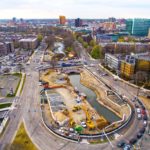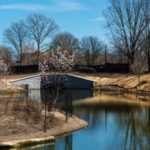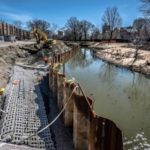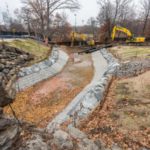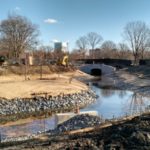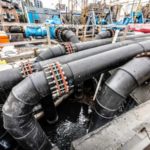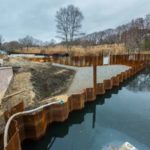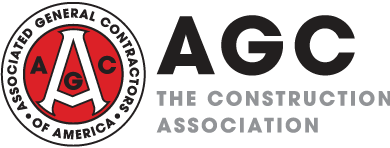- Company: Charter Contracting Company
- Industry: Water/Wastewater
- Location: Boston, Massachusetts
The Muddy River Flood Risk & Restoration (Muddy River) project is the highest-profile design-build project located in the heart of Boston undertaken by the United States Army Corps of Engineers, New England District (CENAE) in the last 20 years. This unique project was driven by a strong Safety Culture, effective stakeholder collaboration, and innovative solutions.
The Muddy River project was a highly complex, multi-scope project situated along a network of rivers known as the Emerald Necklace, a series of parks created by Frederick Olmsted to connect Boston Common and the Public Garden to Franklin Park and to clean up the marshy area known as the Back Bay Fens area of Boston. Historically, the area surrounding the river had been impacted by substantial flooding events that caused extensive damage to surrounding businesses, MBTA and led to road closures. The work Charter performed at the site alleviated the burden that development and commercialization of the area had caused to the river flow by removing the existing, undersized, 6-foot diameter pipes that carried the river flow underground for 1/4 mile, and rebuilding that stretch of river (or daylighting), including installing two 24-foot wide precast arch culverts able to handle heavy flow under two heavy trafficked roadways.
Charter and all affected parties overcame major challenges and never lost site of the project’s importance to history and the interested parties affected by the major flooding events. The project not only significantly reduced the flood risk to the area, but gave back to the community through a much needed green space, while restoring Olmsted’s original vision. Charter completed the project with over 97,600 safe hours without a single lost-time incident.
What impact does this project have on America?
To fully grasp the significance of this project and the impact it has on the community you have to go back to Frederick Law Olmsted’s original vision for Boston’s Back Bay Fens Area. While the project was partly to create a park system in the middle of the city, it also served the functional purpose of providing sanitary improvements. For over 130 years there had been no comprehensive improvements to the river channel. Eventually, commercialization overtook the area and this section of the larger park system was converted to a parking lot in which the river was forced through two small culverts. This change led to massive flooding events which damaged the surrounding area, closed the nearby T-stop, and road closures. The worst was in 1996 when Boston and Brookline experienced a “100-year storm” seeing 7.48-10.72 in of rain in just 36 hours causing $70 million in damage.
To replace the original culverts and prevent future flooding events, the team installed two 24-foot wide by 10-foot high pre-cast concrete arch culverts supported by drilled shafts 3’ diameter and approximately 50 -foot long caissons under existing roadways. Charter also constructed the culvert concrete headwalls and wing walls also supported by caissons, installed granite veneer and capstones, excavated ~50,000 CY to daylight sections of the river, shipped over 81,000 tons of soil, and landscaped the new and existing channel sections. Charter installed new headwalls at the storm drain outlets and Articulated Concrete Blocks at upstream and downstream ends of the culverts. The team constructed the new river bank along the delighted river, as well as the historic Frederick Law Olmstead Island.
These changes to the river had a positive impact on the fishing communities by enhancing the diversity and productivity of the benthic and warm-water fish communities and reducing the PCB levels in the fish allowing for the restoration of the urban recreational fishery.
The area surrounding the project also received massive traffic pattern improvements, freshly paved roads, new traffic lights, and new sidewalks. In a high-traffic volume area close to hospitals, ambulances can not only slow down traffic but lead to noise pollution. With the new pattern, which created a smother and safer flow of traffic and pedestrians, the amount of noise pollution has drastically decreased.
By daylighting the river and allowing it to flow through larger culverts, the project reduced the flood risk, restored Olmsted’s original vision, and increased the value of 140 acres of park for all to enjoy.
In summary, contribution included:• Significantly reduced flood risk
• Provided a much-needed greenspace
• Traffic improvements – less sirens, new traffic lights, new pavement, new sidewalks
• Enhanced diversity and productivity of the benthic and warm water fish communities.
• Enhanced value of over 140 acres of associated upland park areas.
• Allowed restoration of urban recreational fishery (PCB levels in fish reduced).
• Modification of Traffic Patterns reduced Congestion and Eliminated Safety Issues
• Improved Pedestrian and Bicycle Flow in the Area
What interesting obstacles or unusual circumstances did you overcome to complete the project?
The dewatering of the Muddy River was approached with an alternative approach after finding the concept design to be impractical. Essentially, the dewatering of the project was performed in two ways—through cofferdams installed upstream at the project limits, as well as down the center of the river. This allowed work to be performed in the dry on one side and then once that was complete and water flow was restored, dewatering and repeating the process on the opposite side. With the limited amount of laydown space downstream due to the amount of trees on-site that were called to remain, Charter designed a second approach by dewatering the downstream portion of the river and installing a bypass system. This approach allowed for the river reconstruction to be performed in the dry while diverting the water around and eliminating any disturbance or damage to the surrounding trees.
Another component of the project that required an innovative approach was the dredging portion. Hydraulic dredging was not feasible due to the existing trees on-site that were to be protected, as well as the amount of sizable debris in the river, and the shallow depths of the water. To work around these issues, Charter excavated the sediment by containing segments in bays using h-piles and plates. Once sediment was treated (to remove excess moisture) and excavated, the riverbed was constructed and used as a working platform to continue work in the next bay. This allowed for dredging to be completed in the dry, from the center of the river.
The relocation of large, trunk utilities that ran through the project site and fed, most importantly, the hospitals in the area, along with the schools, businesses, residences and Fenway Park, was another complex component that required precise managing and sequencing. Charter was successful in overseeing the relocation of these utilities and working with the various service providers to ensure these crucial utilities ran continuously without interruption.
Typically, a project requires the team to work with one major stakeholder and one or two subsequent parties; however, this project was a bit different. Due to the significance and importance of the project to the community, this project had numerous stakeholders / sponsors and special interest groups following it closely. The stakeholders / sponsors included CENAE, Commonwealth of Massachusetts, Massachusetts Department of Conservation and Recreation, City of Boston, and Town of Brookline. Given its location and impact on the community, Charter was accountable to each and had to consider each when performing work, making traffic changes, and developing its site-specific safety plan. Through Charter’s performance and consideration of all impacted parties in the area, we gained the confidence of our partners’ to make the right decision when the team encountered various complexities.
The Emerald Necklace’s inclusion on the National Register of Historic Places required Charter to stop work in the event that any remnants of historic structures were encountered and uncovered during construction activities. During excavation, the team uncovered remnants of the old Bridle Path Bridge constructed in 1893. Work was immediately stopped and an archaeologist was called in to preserve and catalog this historic find. Once the structure was safely removed by Charter under supervision of archaeologist, work continued.
What dangers and risks did you encounter, and describe any extraordinary methods used to keep workers safe?
Location – The Muddy River site encompasses 8.2 acres and is located in the middle of a heavily-travelled, highly-populated, urban center. The project area is adjacent to a major roadway system, amongst twelve colleges and universities, the Longwood Medical area consisting of six hospitals and research institutions and within close proximity to Fenway Park, focusing a spotlight on Charter’s ability to safely execute a project of this magnitude. To minimize disruptions, Charter developed three revised critical traffic management plans that sequenced the work through eight traffic changes, one of which allowed for the team to execute two stages of work simultaneously. The team also worked 10-hour days, double shifts, on Saturdays, around the Red Sox home game schedule to accommodate increased traffic to the area and provide safe travel for commuters. Major road work was conducted at night to minimize disruptions to traffic.
The dense population of the project area restricted access points to the site and provided minimal construction laydown space. To respond to this challenge, Charter executed a pre-planned, multistage approach that included the meticulous scheduling of all deliveries to site and the precise planning of transportation schedules for traffic in and out of the area.
How did you leverage new technologies to work faster and reduce waste?
Charter’s redesign of the dewatering approach included a state-of-the-art pump system. The pump system was automated and the design is as follows:
Pumped System Design
• Normal flows handled via a variable frequency drive electric pump
• Automated integral variable frequency drive (VFD) to control the pump speed
• Capable of handling 20 Cubic feet per second (9000 Gallons per minute)
• Higher flows rates accommodated by secondary diesel pumps (4 total)
• Automated through use of an analog data responding unit (AnDRU Box) wired to the pumps
• Pressure transducers were installed in the river to measure water levels and send signals to the AnDRU box
• Redundant float controls were installed and connected to the system
The pump system features are as follows:
• Pump system included a wireless remote terminal unit (Alarm Agent)
• The system sent e-mails and texts to the project team in case of loss of power, pump failure, or other necessary alarm triggers
• Completely automated system designed to mimic varying river flows, as the river swelled, additional pumps would turn on automatically to handle the additional flow
• Capable of handling 100 Cubic Feet per Second or 45,000 gallons per minute
Charter also flew a drone throughout the project. The use of the drone was extremely beneficial at the onset of the project for the team to gain a unique “birds-eye” perspective of the project layout, an overview of the traffic constraints and where along the project site limits it would be most impactful (both vehicular and pedestrian). This also helped while mapping out areas that additional signage should be installed to warn commuters of construction activity. Drones were used to map the project’s progression and the footage was reviewed by the project team and the CENAE.
Lastly, Charter used excavators with integrated scales. The scales use state-of-the-art software that provided precise readings and helped improve efficiency for our weighing requirements, as well as increased productivity by allowing our operators to weigh materials in the bucket quickly and accurately. The excavator scales also allowed the team to monitor the total weight of all materials handled by the excavator per truck load further increasing productivity by excluding a step and allowing weighing to be done while transferring materials.
